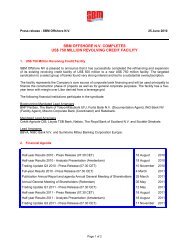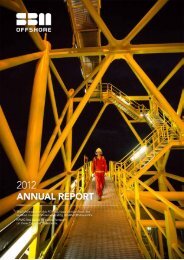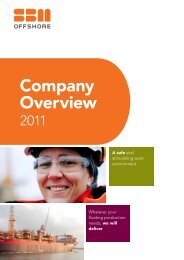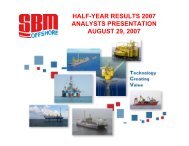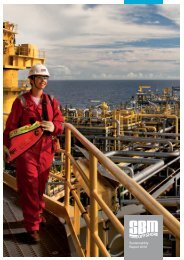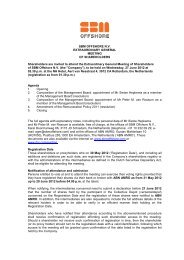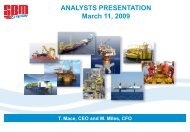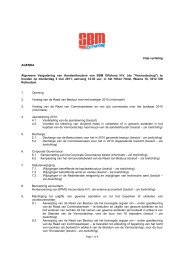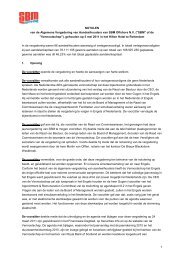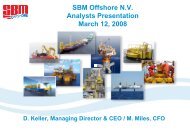Annual Report 2010 - SBM Offshore
Annual Report 2010 - SBM Offshore
Annual Report 2010 - SBM Offshore
Create successful ePaper yourself
Turn your PDF publications into a flip-book with our unique Google optimized e-Paper software.
the consequences of the Deepwater Horizon incident<br />
in <strong>2010</strong> have focused the industry’s attention on pollution<br />
risk even more than before. The management of<br />
pollution risk starts with careful hull selection, conversion<br />
and refurbishment, and continues with a formal<br />
interrogation of the marine, oil and gas process system<br />
design to demonstrate integrity in safety, reliability and<br />
operability. All units presently owned by the Company<br />
have design service lives that extend beyond their contractual<br />
commitments.<br />
Once in service the general integrity of the fleet is maintained<br />
through the application of:<br />
• strict operating and Risk Management procedures,<br />
and preventive maintenance programmes;<br />
• careful selection and intensive training of high-quality<br />
personnel and direct employment of all positions<br />
of responsibility aboard the units;<br />
• continuous survey programme of Hull and Topsides<br />
by the Classification Society;<br />
• management system accreditation and compliance<br />
with the requirements of the International Safety<br />
Management (ISM) Code 2002;<br />
• proactive regulatory compliance.<br />
It should be noted that oil and gas offshore production<br />
activities have been subject to very strict regulatory<br />
regimes for many years, and that the Company is<br />
not active in the ownership or operation of drilling<br />
facilities, for which major new regulatory changes can<br />
be expected.<br />
Protection and Indemnity Club pollution insurance is<br />
purchased for the maximum necessary and available<br />
cover. Indemnities effectively capping the exposure well<br />
below the insured amount are usually obtained from<br />
clients. All of the offshore units are also insured under<br />
comprehensive Hull and Machinery insurance packages<br />
protecting against loss or damage to the unit itself.<br />
Insurance for named windstorm damage in the Gulf of<br />
Mexico is limited to that available for a reasonable price<br />
considering the risk probability and likely impact.<br />
Performance<br />
Lease rates may not be paid or only partially paid by<br />
clients if a unit does not perform as per the contract<br />
requirements in some cases and in other cases incentives<br />
may be reduced or lost. System uptime is assured<br />
<strong>Report</strong> of the Board of Management<br />
by a design process matured from experience, reliability,<br />
availability and maintainability (RAM) modelling,<br />
planned and preventive maintenance as well as condition-based<br />
monitoring. The Company has operated<br />
F(P)SOs for over 200 vessel years with a total operating<br />
downtime of less than 1%, which is well below typical<br />
contractual allowances and above industry median<br />
performance. Insurance coverage for loss of earnings<br />
is contracted only if considered appropriate or as is<br />
sometimes required in relation to debt obligations.<br />
<strong>Offshore</strong> health & safety<br />
The Company has a duty of care to protect the personnel<br />
within its operations from the potential health<br />
hazards posed by hydro-carbon processing and toxic<br />
substances in an offshore environment. Internal expertise<br />
supported by a robust management system and<br />
vessel-specific design and Operational Safety Case<br />
studies are important elements in evaluating and mitigating<br />
risks.<br />
Furthermore, management system codes of practice<br />
covering benzene and mercury management as well as<br />
other hazardous substances, apply onboard F(P)SOs.<br />
Crisis management<br />
The Management System includes Emergency<br />
Contingency Planning which describes the procedures<br />
for responding efficiently and in a predetermined way to<br />
an emergency on board an offshore unit.<br />
In case of an emergency, a Monaco Emergency Control<br />
Centre (MECC) is ready to be activated, consisting of:<br />
• Emergency Control Room, under the responsibility<br />
of the Production Operations Manager;<br />
• Infrastructure to enable direct lines of communication<br />
between all relevant parties;<br />
• Relative Response Room, to facilitate direct communication<br />
with the families of the offshore crew;<br />
• Media Response Room.<br />
Corresponding emergency management arrangements<br />
are provided in the overseas management offices.<br />
Emergency response simulation exercises are held regularly<br />
involving the offshore units and the ‘in country’<br />
management offices, the MECC, local facilities, and clients.<br />
A debriefing takes place immediately following the<br />
termination of the exercise which is fully documented<br />
<strong>SBM</strong> <strong>Offshore</strong> – <strong>Annual</strong> <strong>Report</strong> <strong>2010</strong> 91



